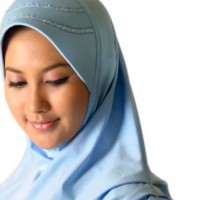What is Hijab?

Overview
In cultures around the world one can see a beautiful array of traditional Muslim dress. Traveling through countries Africa, the Middle East, South Asia, the Malay archipelago and South Eastern Europe – a stunning diversity of color, patterns, prints and materials greet the eyes. Traditional Muslim clothing not only reflects the culture of the people and creativity of the clothiers, it comes from a time honored tradition of using locally grown materials, organic dyes and is especially suited to the climatic conditions of each region. Within this huge range of fashion is a simple unifying principle – modesty.
“Tell the believing men to lower their gaze and guard their private parts: that is purer for them. Surely God is aware of everything they do.” (Quran 24:30)
In every tradition and culture, there is a concept of “appropriate dress.” In the west we have dress codes at restaurants, there is business attire, casual clothing, formal wear and so forth. Within the Islamic tradition, one essential principle regarding dress is that it not be indecent. Muslim men have a responsibility to dress modestly just as much as Muslim woman. In fact, “modesty” is not limited to clothing either. Muslim men are obligated to treat women with respect, dignity and honor. Ogling or leering at women is forbidden. Inappropriate touching or remarks are also forbidden. Making a woman feel that she is being objectified or harassed in any way is not only against Islamic principles and values, it is considered a serious character flaw.
“And tell the believing women that they should lower their gaze, guard their private parts, and not display their beauty except for what normally shows; and to draw their veils over their bosoms.” (Quran 24:31)
Modest dress and behavior is a divinely prescribed responsibility for Muslims of both genders. The Prophet Muhammad (peace be upon him) described modesty as the distinctive quality of Islam. And yet the hijab did not bar women from being prominent and active participants in the Prophet’s community. Whether it was in the field of worship, business, education, charitable work, community and even military service, women were acclaimed for their notable roles in the Prophetic era.
The hijab involves wearing clothing that is not tight fitting and that covers a woman’s body with the exception of her face, hands and feet. This is required when a woman would be in the presence of men who are not closely related to her. The hijab is not required in front of a woman’s father, husband, brothers, sons, grandfathers, grandsons, father-in-law, sons-in-law, nephews, minor male children or elderly men.
Further Reading
Not too long ago there used to be a very sexist saying that “Women should be seen and not heard.” At one time in the west the notion that women should be valued for their bodies but not valued for their minds was acceptable. A very similar sort of misogyny existed at the time of the Prophet Muhammad, peace be upon him, in 7th century Arabia. With the advent of Islam, the modest dress of a Muslim woman (hijab in Arabic) became a barrier to treating women as sexual objects. Interestingly enough, one of the meanings of the word hijab is barrier. The hijab not only forced men to think of women in different terms, it allowed women to understand that their true worth was far more than physical beauty. The Prophet Muhammad peace be upon him taught his followers “God does not look upon your bodies and wealth rather He looks toward your hearts and deeds.”
It is often difficult for Muslim women living in western countries to understand why they are thought of as being “foreign” or inferior when one of the most venerated woman in western (and Islamic) history was Mary the mother of Jesus (peace be upon him). Many Muslim women dress in a manner that is very similar to popular representations of Mary (may God be pleased with her). And yet there are attempts by various western governments to deny Muslim women basic rights as citizens simply because of the way they dress. Even more insidious is the discrimination that goes on in the job market. Muslim women report being told there are no vacancies despite want ads asking people to apply. There have also been high profile cases of large corporations discriminating against hijab wearing employees.
On the other hand there are some Muslim countries where women are expected to go beyond the norms of the Quran and are penalized by the legal system if they fail to do so. The Prophet Muhammad, peace be upon him, never mandated the use of face veils (niqab in Arabic) for all women and yet some Muslim countries have made it the law. Similarly, there are no prescribed penalties in Islamic law for women if they do not observe the hijab (or the niqab) but several Muslim countries have chosen to adopt such measures. Respect for all women is a fundamental principle in Islam. A Muslim woman wearing hijab is not necessarily more pious than a Muslim woman who does not. Moreover many Muslim women who wear it often came to the decision after years of soul-searching. As hijab is considered an act of worship, its observance should be broached with great compassion and wisdom. Unfortunately, in two distinct regions of the world, some Muslim women have found themselves victims of two opposing forms of extremism.